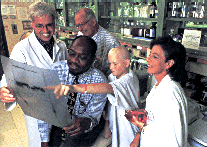Promising New Research in Pediatrics Under Way
 (From left:) Drs. Mark Roberts, Theodore Zipf, Eugenie Kleinerman and
Francis Ali-Osman (seated) are conducting research that one day may translate into
promising new therapies and help pediatric
(From left:) Drs. Mark Roberts, Theodore Zipf, Eugenie Kleinerman and
Francis Ali-Osman (seated) are conducting research that one day may translate into
promising new therapies and help pediatric